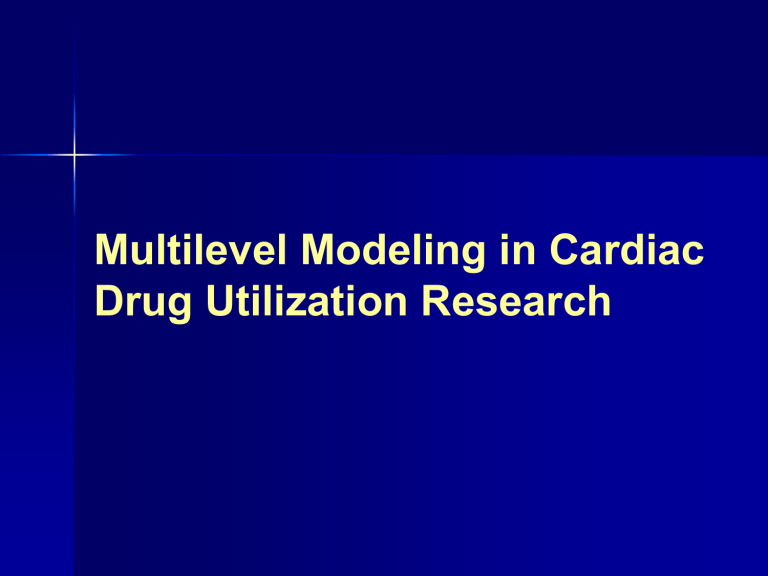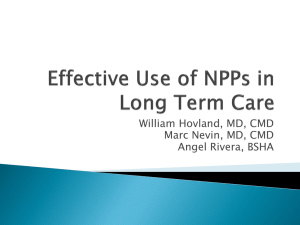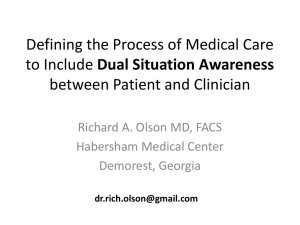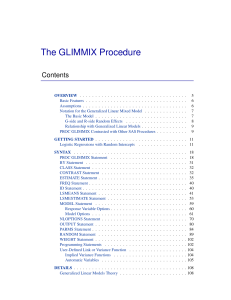Multilevel_Modeling_..

Multilevel Modeling in Cardiac
Drug Utilization Research
Outline
PROC GLIMMIX introduction
Cardiac drug utilization research using multilevel models.
Multilevel data
Multilevel data are common in observational study in social science, health care field.
Clinical trials carried out in serveral random selected center or groups of subjects create data hierarchies
The Research Question
Investigate clinical and non-clinical factors associated with prescription of cardiac drugs for patients discharged after catheterization.
Heart Catheterization
Inclusion/Exclusion
Criteria
Include All patients underwent the
1 st CATH from 1999/07 to 2002/10
Exclude patients with age<20, non-
BC patients, prior CABG or PCI, in hospital death, discharged to extended care
Exclude patients with normal angiogram
Drugs of interests
ACE Inhibitor
Beta Blocker
Statin
Optimum drug
Factor of Interest
Patient level: sex, age, extent of disease (blockage), prior drug, ejection fraction, prior MI, DM, renal, HPD, HTN,
PVD, CVA, CHF, COPD, liver disease, urgency, indication, cardiac re-hospitalization, transfer history, length of hospital stay, revascularization,
Hospital level: teaching hospital
Physician level: year of service, volume of service
Neighbourhood level:
Median family income, univeristy education rate, immigration rate
Assumption
1 st Catheterization
120 days
Admission Discharge
Data Structure
The data set consists 22847 patients
Hospital level: Patients discharged from 67 BC hospitals with hospital cluster size from 1 to 4403 patients; 97% patients discharged from hospital with cluster size>100.
Physician level: Patients discharged by 1059 physicians
(with anywhere between 1 to 785); 72% patients discharged by physician with cluster size >100).
Census tract level: Patients came from 695 census tract with census tract cluster size from 1 to 342, 73% patients came from census tract with cluster size>30.
Data Structure
Hospital
Physician
Patient
Neighbourhoods
Cross random intercept model
y i
~ Bernouilli ( π i
)
Logit(π i
) = β
0i
β
0i
= β
0
+ δ
+ β hosp(i)
(2)
1 x
1i
+ δ doc(i)
(3) + δ tract(i)
(4)
Where i indexes the patient i, and hosp(i), doc(i), and tract(i) are functions that return the unit number of the hospital, doctor, and census tract, respectively, that patient i belong to.
Cross random intercept model
y i
~ Bernouilli ( π i
)
Logit(π i
) =β
0
+ β
1 x
1i
+ δ hosp(i)
(2) + δ doc(i)
(3) + δ tract(i)
(4)
δ hosp(i)
(2) ~ N (0, σ
δ(2)
2
δ doc(i)
(3) ~ N (0, σ
δ(3)
2 )
)
δ tract(i)
(4) ~ N (0, σ
δ(4)
2 )
Allow coefficient to vary across the classification
Suppose β
1i represent heart failure, we want to know whether the impact of heart failure vary across the hospital classification, we would use cross random coefficient model to investigate that.
Cross random coefficient model
y i
~ Bernouilli ( π i
)
Logit(π i
) = β
0i
β
0i
β
1i
= β
= β
0
1
+ δ
+ δ
+ β
1i hosp(i),0
(2) hosp(i),1
(2) x
1i
+ δ doc(i)
(3) + δ tract(i)
(4)
Where δ hosp(i),0
(2) and δ hosp(i),1
(2) representing the hospital random intercept effects and random slope effects, respectively.
Which procedure to use?
Model Response type Random effects
LOGISTIC Binary
GLM Interval
NO
NO
GENMOD Categorical, Interval NO
MIXED Interval Yes
NLMIXED Categorical, Interval Yes, but not suitable for complex random effects
GLIMMIX Categorical, Interval Yes, suitable for complex random effects
Where to get proc glimmix
The glimmix procedure is a new procedure in SAS/STAT software. It is an add-on for the SAS/STAT product in SAS 9.1 on either the
Windows or Linux platform. It is currently downloadable for the SAS
9.1 release from software downloads at support.sas.com.
Two level glimmix
proc glimmix data=glim_dataF IC=Q; class sex ageGP65 dis_hosp ; model drug(event= 'YES' )=sex ageGP65/solution dist=binary link=logit ddfm=bw oddsratio; random int / subject=dis_hosp; run ;
Three level glimmix
proc glimmix data=glim_dataF IC=Q; class sex ageGP65 dis_hosp dis_phy; model drug(event= 'YES' )=sex ageGP65/solution dist=binary link=logit ddfm=bw oddsratio; random int / subject=dis_phy(dis_hosp); run ;
Order in the class statement
Value of ORDER= Levels Sorted By
DATA order of appearance in the input data set
FORMATTED external formatted value, except for numeric variables with no explicit format, which are sorted by their unformatted (internal) value
FREQ descending frequency count; levels with the most observations come first in the order
INTERNAL unformatted value
Proc glimmix
Advantage
• Allows multiple random effects, nested and crossed random effects
• Allows subject-specific and populationaveraged inference
• Allows nonnormal distribution of response
Disadvantage
• The absence of a true log likelihood
• The computation of cross effects model is time consuming
Upcoming features in proc glimmix in SAS 9.2
The COVTEST statement for likelihood-based testing and confidence intervals for covariance parameters.
Better output format?
Effects of ignoring Nested
Structure
Covariance Estimates Hospital(SE) Physician(SE) Census Tract(SE)
ACE Inhibitor Hospital 0.17(0.07)
Physician
Physician(Hospital)
Physician(Hospital)
*census tract
Beta Blocker Hospital
Physician
0.32(0.06)
0.14(0.06) 0.22(0.04)
0.14(0.06)
0.18(0.07)
0.22(0.04)
0.26(0.04)
0.02(0.01)
0.19(0.07) 0.10(0.02)
Statin
Physician(Hospital)
Physician(Hospital)
*census tract
Hospital
Physician
Physician(Hospital)
Physician(Hospital)
*census tract
Optimum Rx Hospital
Physician
Physician(Hospital)
Physician(Hospital)
*census tract
0.19(0.07) 0.10(0.02)
0.19(0.07)
0.20(0.08)
0.19(0.07)
0.20(0.07)
0.20(0.07)
0.19(0.07)
0.39(0.06)
0.21(0.04)
0.20(0.04)
0.24(0.04)
0.09(0.02)
0.10(0.02)
0
0.02(0.01)
0.02(0.01)
Effects of ignoring Nested
Structure
Ignoring the hospital hierarchy leads to inflation of physician variance estimates drasticly
Adding the cross effect of census tract on hospital-physician nested hierarchy doesn’t change the hospital and physician variance.
Does Teaching hospital help to explain the variation at hospital level?
Covariance Estimates Hospital(SE) Phyician(SE) census Tract(SE)
ACE Ihibitor intercept model 0.11(0.04) 0.25(0.04) 0.03(0.01) patient level variable model 0.14(0.06) 0.26(0.05) 0.02(0.01)
Patient level variable + high level variable model
Beta Blocker intercept model
0.14(0.06) 0.22(0.04) 0.02 (0.01)
0.14(0.05) 0.11(0.02) 0.004(0.006) patient level variable model 0.17(0.07) 0.11(0.03) 0
Patient level variable +
Statin high level variable model intercept model
0.19(0.07) 0.10(0.02) 0
0.14(0.05) 0.21(0.04) 0.04(0.01) patient level variable model 0.19(0.07) 0.20(0.04) 0.03(0.01)
Patient level variable + high level variable model
Optimum Rx intercept model patient level model
Patient level variable + high level variable model
0.19(0.07) 0.20(0.04) 0.02(0.01)
0.16(0.05) 0.14(0.02) 0.03(0.01)
0.18(0.06) 0.10(0.02) 0.02(0.01)
0.19(0.07) 0.10(0.02) 0.02(0.01)
Cross effects model
Does Teaching hospital help to explain the variation at hospital level?
Teaching hospital effect does not explain the variation at hospital level
Service years of physician and physician service volume only explain very little of the variation at physician level
ACE Inhibitor single level LR vs. multilevel LR
Years of service Q1 vs Q4
Q2 vs Q4
Volume of service
Q3 vs Q4
Q1 vs Q4
Q2 vs Q4
Q3 vs Q4
Teaching Hospital
Immigration Rate Q5 vs Q1
Q4 vs Q1
Q3 vs Q1
Q2 vs Q1
OR LowerCL UpperCL
1.34
1.22
1.48
1.24
0.91
1.05
0.83
1.47
1.01
0.87
0.99
1.01
0.74
0.90
0.86
1.03
1.10
1.17
0.90
0.93
1.00
1.04
0.90
0.97
0.94
0.97
0.68
0.72
0.91
0.87
0.83
0.92
1.39
1.20
0.61
0.60
0.83
0.74
0.75
0.79
1.28
0.68
0.81
0.81
0.90
0.92
0.81
0.86
0.84
0.86
1.01
1.06
1.12
1.19
1.01
1.09
1.04
1.09
0.77
0.86
1.01
1.03
0.91
1.06
1.51
2.13
1 st row:: Single level LR results
2 nd row: multilevel
LR results
Beta Blocker single level LR vs. multilevel LR
Years of service Q1 vs Q4
Q2 vs Q4
Q3 vs Q4
Volume of service Q1 vs Q4
Q2 vs Q4
Q3 vs Q4
Teaching Hospital
Immigration Rate Q5 vs Q1
Q4 vs Q1
Q3 vs Q1
Q2 vs Q1
OR
1.19
1.16
LowerCL UpperCL
1.08
1.01
1.30
1.35
1.07
1.10
0.97
1.08
0.97
0.94
0.88
0.94
1.18
1.28
1.07
1.24
0.91
0.93
0.77
0.88
0.86
0.97
0.92
0.97
0.86
0.76
0.82
0.78
0.94
0.93
1.70
1.36
0.77
0.65
0.74
0.68
0.86
0.81
1.57
0.71
0.81
0.82
0.69
0.78
0.78
0.87
0.83
0.87
1.02
1.06
0.86
0.99
0.96
1.08
1.02
1.08
0.96
0.89
0.90
0.91
1.04
1.06
1.84
2.58
1 st row:: Single level LR results
2 nd row: multilevel
LR results
Statin single level LR vs. multilevel LR
Years of service Q1 vs Q4
Q2 vs Q4
Q3 vs Q4
Volume of service Q1 vs Q4
Q2 vs Q4
Q3 vs Q4
Teaching Hospital
Immigration Rate Q5 vs Q1
Q4 vs Q1
Q3 vs Q1
Q2 vs Q1
0.97
1.03
0.68
0.75
0.87
0.94
0.93
0.91
1.09
OR
1.31
LowerCL UpperCL
1.18
1.45
1.16
1.18
1.17
1.20
0.98
1.06
0.98
1.08
1.38
1.32
1.39
1.33
1.14
0.99
1.00
1.13
1.04
0.95
0.95
0.97
0.88
0.83
1.02
0.88
0.86
0.82
1.33
1.12
1.20
1.26
1.23
1.06
1.11
0.89
0.53
0.61
0.65
0.77
0.81
0.82
0.80
0.96
1.06
1.98
0.77
0.86
0.98
1.08
1.04
1.04
1.22
1 st row:: Single level LR results
2 nd row: multilevel
LR results
Optimum Rx single level LR vs. multilevel LR
Years of service Q1 vs Q4
Q2 vs Q4
Volume of service
Q3 vs Q4
Q1 vs Q4
Q2 vs Q4
Q3 vs Q4
Teaching Hospital
Immigration Rate Q5 vs Q1
Q4 vs Q1
Q3 vs Q1
Q2 vs Q1
OR
1.33
1.22
1.13
1.11
0.99
1.08
LowerCL UpperCL
1.22
1.07
1.44
1.38
1.04
0.97
0.91
0.95
1.23
1.27
1.07
1.22
1.42
1.28
0.77
0.84
0.86
0.98
0.86
0.83
1.00
0.93
0.90
0.92
0.86
0.95
0.93
0.97
1.32
0.68
0.70
0.75
0.78
0.88
0.78
0.72
0.91
0.82
0.83
0.82
0.78
0.85
0.85
0.88
1.52
2.42
0.84
0.94
0.94
1.10
0.95
0.96
1.09
1.06
0.98
1.04
0.94
1.06
1.02
1.08
1 st row:: Single level LR results
2 nd row: multilevel
LR results
Implication of the results
Compared to the cross effects models, the standard errors of teaching hospital effect from the single-level logistic regression are much smaller and lead to an invalid finding of significant teaching hospital effect.
Between census tract variance is fairly small. We keep the census tract random effects in the model as we want to examine the influence of immigration rate on drug utilization.
Reference
Judith D.Singer. Using SAS PROC MIXED to fit multilevel models, Hierarchical models, and individual growth models. Journal of Educational and Behavioral Statistics
1998; 24, 323-355
Jone Rasbash , William Brown. Non-hierarchical multilevel models.
Tony Blakely, S V Subramanian. Multilevel Studies. In
Oakes M, Kaufman J, eds, Methods for social epidemiology, Jossey Bass: San Francisco. 2005: in press.






